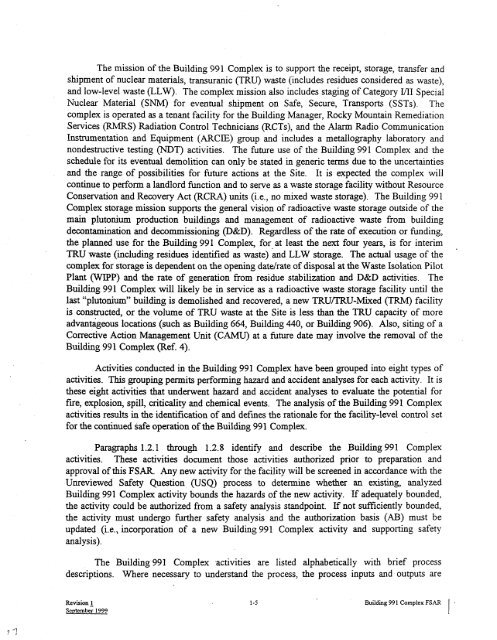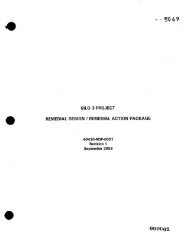closure project manager - Document Request - U.S. Department of ...
closure project manager - Document Request - U.S. Department of ...
closure project manager - Document Request - U.S. Department of ...
Create successful ePaper yourself
Turn your PDF publications into a flip-book with our unique Google optimized e-Paper software.
? ’7<br />
The mission <strong>of</strong> the Building 991 Complex is to support the receipt, storage, transfer and<br />
shipment <strong>of</strong> nuclear materials, transuranic (TRU) waste (includes residues considered as waste),<br />
and low-level waste (LLW). The complex mission also includes staging <strong>of</strong> Category LrlI Special<br />
Nuclear Material (SNMJ for eventual shipment on Safe, Secure, Transports (SSTs). The<br />
complex is operated as a tenant facility for the Building Manager, Rocky Mountain Remediation<br />
Services (RMRS) Radiation Control Technicians (RCTs), and the Alarm Radio Communication<br />
Instrumentation and Equipment (ARCIE) group and includes a metallography laboratory and<br />
nondestructive testing (NDT) activities. The future use <strong>of</strong> the Building 991 Complex and the<br />
schedule for its eventual demolition can only be stated in generic terms due to the uncertainties<br />
and the range <strong>of</strong> possibilities for future actions at the Site. It is expected the complex will<br />
continue to perform a landlord function and to serve as a waste storage facility without Resource<br />
Conservation and Recovery Act (RCRA) units @e., no mixed waste storage). The Building 991<br />
Complex storage mission supports the general vision <strong>of</strong> radioactive waste storage outside <strong>of</strong> the<br />
main plutonium production buildings and management <strong>of</strong> radioactive waste from building<br />
decontamination and decommissioning (D&D). Regardless <strong>of</strong> the rate <strong>of</strong> execution or funding,<br />
the planned use for the Building 991 Complex, for at least the next four years, is for interim<br />
TRU waste (including residues identified as waste) .and LLW storage. The actual usage <strong>of</strong> the<br />
complex for storage is dependent on the opening datdrate <strong>of</strong> disposal at the Waste Isolation Pilot<br />
Plant ONIpP) and the rate <strong>of</strong> generation from residue stabilization and D&D activities. The<br />
Building 991 Complex will likely be in service as a radioactive waste storage facility until the<br />
last “plutonium” building is demolished and recovered, a new TRU/TRU-Mixed (TRMJ facility<br />
is constructed, or the volume <strong>of</strong> TRU waste at the Site is less than the TRU capacity <strong>of</strong> more<br />
advan&eous locations (such as Building 664, Building 440, or Building 906). Also, siting <strong>of</strong> a<br />
Corrective Action Management Unit (0 at a future date may involve the removal <strong>of</strong> the<br />
Building 991 Complex (Ref. 4).<br />
Activities conducted in the Building 991 Complex have been grouped into eight types <strong>of</strong><br />
activities. This grouping permits performing hazard and accident analyses for each activity. It is<br />
these eight activities that underwent hazard and accident analyses to evaluate the potential for<br />
fire, explosion, spill, criticality and chemical events. The analysis <strong>of</strong> the Building 991 Complex<br />
activities results in the identification <strong>of</strong> and defmes the rationale for the facility-level control set<br />
for the continued safe operation <strong>of</strong> the Building 99 1 Complex.<br />
Paragraphs 1.2.1 through 1.2.8 identify and describe the Building 991 Complex<br />
activities. These activities document those activities authorized prior to preparation and<br />
approval <strong>of</strong> this FSAR. Any new activity for the facility will be screened in accordance with the<br />
Unreviewed Safety Question (USQ) process to determine whether an existing, analyzed<br />
Building 991 Complex activity bounds the hazards <strong>of</strong> the new activity. If adequately bounded,<br />
the activity could be authorized from a safety analysis standpoint. If not sufficiently bounded,<br />
the activity must undergo further safety analysis and the authorization basis (AB) must be<br />
updated &e., incorporation <strong>of</strong> a new Building 991 Complex activity and supporting safety<br />
analysis).<br />
The Building 991 Complex activities are listed alphabetically with brief process<br />
descriptions. Where necessary to understand the process, the process inputs and outputs are<br />
Revision 1-5 Building 99 1 Complex FSAR<br />
Scpkrnber 1999<br />
I<br />
~
















